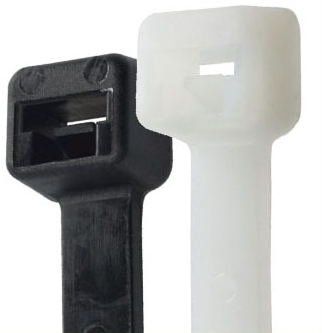Cable ties are indispensable tools for bundling, securing, and organizing a wide range of materials. One of the most important factors to consider when selecting cable ties is their loop tensile strength, which indicates how much weight the tie can handle without breaking. A common rating is 50lb loop tensile strength, but is this sufficient for your needs?
This article explores what 50lb loop tensile strength means, when it’s enough, and the applications where it performs best.
 While 50lb loop tensile strength is versatile, some applications require stronger cable ties. Consider ties with a higher tensile strength for:
While 50lb loop tensile strength is versatile, some applications require stronger cable ties. Consider ties with a higher tensile strength for:
What Does 50lb Loop Tensile Strength Mean?
The term loop tensile strength refers to the amount of weight a cable tie can withstand before breaking when the loop is pulled. A 50lb rating means the cable tie can handle up to 50 pounds of tension without failure. This rating reflects the tie's strength and reliability, making it suitable for a variety of light to moderate-duty applications.When Is 50lb Loop Tensile Strength Enough?
1. Home and Office Use
For organizing cables, wires, or lightweight items, a 50lb loop tensile strength is more than sufficient. These ties securely hold bundles of cords under desks, behind entertainment systems, or in workshops. Their strength ensures durability, even in setups that require frequent adjustments.2. Automotive Applications
In vehicles, 50lb cable ties perform well for securing wiring harnesses, hoses, and small components. They provide enough strength to withstand vibrations and moderate tension without snapping.3. DIY Projects
From bundling garden tools to temporary repairs, 50lb cable ties handle most everyday tasks. They are ideal for projects that require quick and reliable fastening, especially when the load doesn’t exceed the specified weight limit.4. Electronics and Networking
For managing cables in server rooms, data centers, or residential setups, 50lb ties are both strong and easy to use. They securely fasten cables without damaging insulation, maintaining an organized and safe environment.5. Temporary Outdoor Use
For lightweight outdoor applications like securing decorations, banners, or lightweight structures, 50lb tensile strength offers adequate performance. However, ensure the ties are UV-resistant if exposed to sunlight for extended periods. Learn more: Do Cable Ties Conduct Electricity?When to Consider Higher Tensile Strength
 While 50lb loop tensile strength is versatile, some applications require stronger cable ties. Consider ties with a higher tensile strength for:
While 50lb loop tensile strength is versatile, some applications require stronger cable ties. Consider ties with a higher tensile strength for:
- Heavy-Duty Industrial Tasks: Securing large bundles of cables or equipment.
- Construction Projects: Fastening materials in high-stress environments.
- Harsh Weather Conditions: Extreme temperatures or prolonged exposure to UV radiation can weaken lighter ties.
- Heavy Machinery: Applications involving significant vibrations or heavy components demand higher tensile strength for reliability.
Factors Affecting Cable Tie Performance
When evaluating whether 50lb tensile strength is enough, consider these factors:- Load Weight: Ensure the combined weight of the items doesn’t exceed the tie’s rating.
- Environmental Conditions: Extreme temperatures, chemicals, or UV exposure can reduce the tie's effectiveness.
- Frequency of Use: Repeated adjustments or tensioning may weaken the tie over time.
Tips for Maximizing the Performance of 50lb Cable Ties
- Choose the Right Material: Opt for UV-resistant ties for outdoor use and flame-retardant ties for high-temperature environments.
- Distribute Weight Evenly: Use multiple ties for larger bundles to prevent overloading a single tie.
- Avoid Overtightening: Tighten the tie just enough to secure the bundle without damaging cables or the tie itself.
- Inspect Regularly: Check for signs of wear or degradation, especially in demanding environments.
